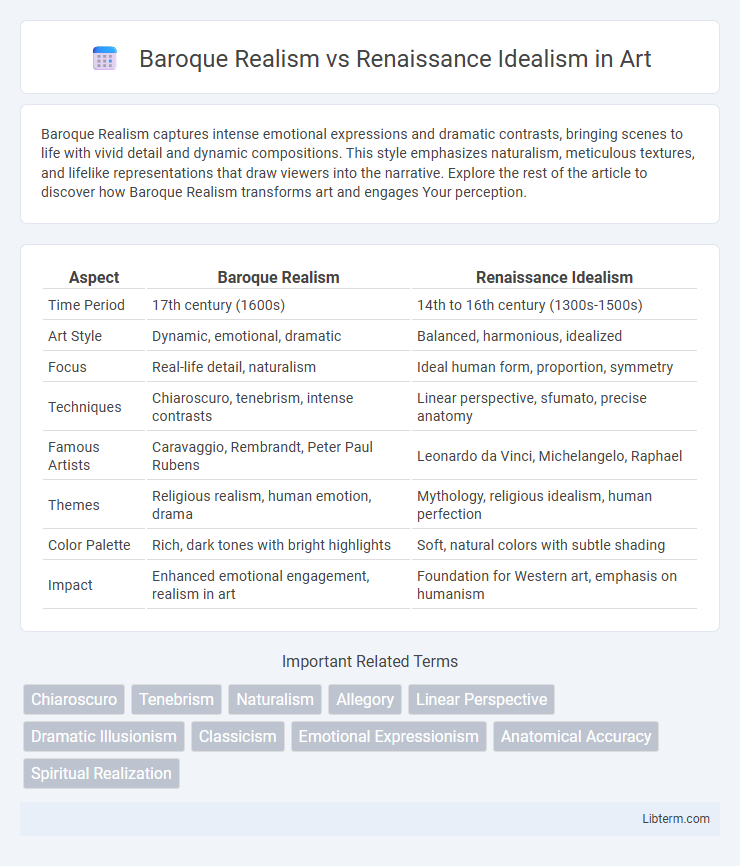Baroque Realism captures intense emotional expressions and dramatic contrasts, bringing scenes to life with vivid detail and dynamic compositions. This style emphasizes naturalism, meticulous textures, and lifelike representations that draw viewers into the narrative. Explore the rest of the article to discover how Baroque Realism transforms art and engages Your perception.
Table of Comparison
| Aspect | Baroque Realism | Renaissance Idealism |
|---|---|---|
| Time Period | 17th century (1600s) | 14th to 16th century (1300s-1500s) |
| Art Style | Dynamic, emotional, dramatic | Balanced, harmonious, idealized |
| Focus | Real-life detail, naturalism | Ideal human form, proportion, symmetry |
| Techniques | Chiaroscuro, tenebrism, intense contrasts | Linear perspective, sfumato, precise anatomy |
| Famous Artists | Caravaggio, Rembrandt, Peter Paul Rubens | Leonardo da Vinci, Michelangelo, Raphael |
| Themes | Religious realism, human emotion, drama | Mythology, religious idealism, human perfection |
| Color Palette | Rich, dark tones with bright highlights | Soft, natural colors with subtle shading |
| Impact | Enhanced emotional engagement, realism in art | Foundation for Western art, emphasis on humanism |
Introduction to Baroque Realism and Renaissance Idealism
Baroque Realism emphasizes dynamic movement, intense emotion, and intricate detail to capture the complexity of human experience, contrasting with Renaissance Idealism's focus on harmony, proportion, and the pursuit of idealized beauty rooted in classical principles. Baroque artists such as Caravaggio used chiaroscuro and dramatic contrasts to create lifelike, emotionally charged scenes, while Renaissance painters like Leonardo da Vinci and Raphael prioritized balanced compositions and anatomical perfection to convey timeless ideals. This divergence reflects broader cultural shifts from the orderly, human-centric worldview of the Renaissance to the emotionally rich, often turbulent Baroque era.
Historical Context: Baroque vs Renaissance Art
Baroque realism emerged in the 17th century amid the Counter-Reformation, emphasizing emotional intensity, dramatic lighting, and vivid naturalism to engage viewers and communicate religious themes effectively. Renaissance idealism, flourishing in the 15th and 16th centuries, celebrated balanced composition, harmonious proportions, and anatomical perfection inspired by classical antiquity and humanist philosophy. These contrasting historical contexts influenced Baroque art's dynamic, expressive style and Renaissance art's pursuit of ideal beauty and intellectual clarity.
Philosophical Foundations: Realism and Idealism Explained
Baroque Realism emphasizes empirical observation and the tangible, reflecting a philosophical foundation rooted in realism, where truth is derived from sensory experience and the physical world. Renaissance Idealism is grounded in Platonic philosophy, prioritizing ideal forms and the perfection of abstract concepts, aiming to depict an idealized vision of beauty and humanity. These contrasting philosophies shape the distinct artistic approaches: Baroque Realism captures dynamic authenticity, while Renaissance Idealism pursues harmonious idealization.
Key Artistic Characteristics of Renaissance Idealism
Renaissance Idealism emphasizes harmony, proportion, and balanced composition, reflecting the pursuit of perfect beauty inspired by classical antiquity. Artists focus on anatomically accurate human figures depicted with idealized forms, clarity, and restrained emotion to convey rationality and order. Use of linear perspective and chiaroscuro enhances the sense of depth and three-dimensionality while maintaining symmetry and visual equilibrium.
Defining Features of Baroque Realism
Baroque Realism is characterized by dramatic use of light and shadow (chiaroscuro), intense emotional expression, and dynamic compositions that emphasize movement and realism. Unlike Renaissance Idealism, which emphasizes harmonious proportions and idealized forms, Baroque Realism captures raw, often imperfect human details to evoke visceral responses. This style frequently employs vivid contrasts and textured surfaces to enhance the sense of immediacy and tangible presence in the artwork.
Master Artists: Comparing Influential Figures
Caravaggio and Rembrandt are iconic Baroque Realism masters known for their dramatic use of chiaroscuro and intense emotional expression, contrasting sharply with Renaissance Idealism exemplified by Leonardo da Vinci and Raphael, who emphasized harmony, proportion, and idealized human forms. Michelangelo's dynamic sculptures embody Renaissance ideals of anatomical perfection, while Bernini's Baroque works capture movement and raw human emotion, reflecting a shift toward naturalism and complexity. The artistic achievements of these masters highlight the ideological transition from the balanced, orderly compositions of the Renaissance to the expressive, realistic narratives of the Baroque period.
Techniques and Mediums: Aesthetic Differences
Baroque Realism emphasizes dramatic contrasts through chiaroscuro and textured brushwork, utilizing oil paints to create lifelike depth and emotional intensity in portraits and still lifes. Renaissance Idealism prioritizes balanced composition and idealized forms, employing fresco and tempera to achieve smooth surfaces and harmonious proportions in religious and mythological scenes. These aesthetic differences reflect Baroque's focus on dynamic realism versus Renaissance's pursuit of ideal beauty and symmetry.
Representation of Human Experience and Emotion
Baroque Realism captures the raw intensity of human experience through dramatic contrasts, dynamic compositions, and vivid emotional expressions, emphasizing authenticity and immediacy. Renaissance Idealism, in contrast, presents a perfected vision of humanity, focusing on balance, harmony, and ideal proportions to convey universal beauty and intellectual refinement. Baroque art's visceral portrayal of emotion contrasts with the Renaissance pursuit of idealized, serene figures, reflecting differing philosophical approaches to human nature and experience.
Legacy and Influence on Modern Art
Baroque Realism's vivid emotional expression and dramatic use of light and shadow profoundly influenced modern art movements such as Expressionism and Surrealism, emphasizing psychological depth and dynamic composition. Renaissance Idealism, with its focus on harmony, proportion, and anatomical precision, laid the foundational principles for Neoclassicism and contemporary figurative arts, promoting balance and idealized human forms. Both styles collectively shaped modern artistic approaches by merging emotional intensity with rigorous structural aesthetics.
Conclusion: Lasting Impact on Art History
Baroque Realism's enduring impact lies in its vivid emotional depth and dramatic use of light, influencing modern narrative techniques and immersive visual storytelling. Renaissance Idealism's legacy persists in its pursuit of balance, proportion, and harmony, shaping classical aesthetics and foundational art education. Together, these movements defined contrasting yet complementary paradigms, enriching art history through dynamic expression and idealized form.
Baroque Realism Infographic

 libterm.com
libterm.com